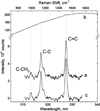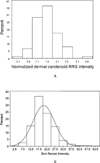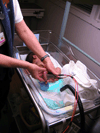Resonance Raman spectroscopic evaluation of skin carotenoids as a biomarker of carotenoid status for human studies
- PMID: 23823930
- PMCID: PMC3818359
- DOI: 10.1016/j.abb.2013.06.007
Resonance Raman spectroscopic evaluation of skin carotenoids as a biomarker of carotenoid status for human studies
Abstract
Resonance Raman spectroscopy (RRS) is a non-invasive method that has been developed to assess carotenoid status in human tissues including human skin in vivo. Skin carotenoid status has been suggested as a promising biomarker for human studies. This manuscript describes research done relevant to the development of this biomarker, including its reproducibility, validity, feasibility for use in field settings, and factors that affect the biomarker such as diet, smoking, and adiposity. Recent studies have evaluated the response of the biomarker to controlled carotenoid interventions, both supplement-based and dietary [e.g., provision of a high-carotenoid fruit and vegetable (F/V)-enriched diet], demonstrating consistent response to intervention. The totality of evidence supports the use of skin carotenoid status as an objective biomarker of F/V intake, although in the cross-sectional setting, diet explains only some of the variation in this biomarker. However, this limitation is also a strength in that skin carotenoids may effectively serve as an integrated biomarker of health, with higher status reflecting greater F/V intake, lack of smoking, and lack of adiposity. Thus, this biomarker holds promise as both a health biomarker and an objective indicator of F/V intake, supporting its further development and utilization for medical and public health purposes.
Keywords: Beta-carotene; Biomarker; Carotenoids; Resonance Raman spectroscopy; Skin.
Copyright © 2013 Elsevier Inc. All rights reserved.
Figures



References
-
- Canene-Adams K, Erdman JJW. Absorption, Transport, Distribution in Tissues and Bioavailability. In: Britton G, Liaaen-Jensen S, Pfander H, editors. Carotenoids Volume 5: Nutrition and Health. Basel, Switzerland: Birkhauser Verlag; 2009.
-
- Institute of Medicine, National Academy of Sciences, Food and Nutrition Board, Panel on Dietary Antioxidants and Related Compounds. Dietary Reference Intakes for Vitamin C, Vitamin E, Selenium, and Carotenoids. Washington: National Academy Press; 2000.
-
- Lin S, Quaroni L, White WS, et al. Localization of carotenoids in plasma low-density lipoproteins studied by surface-enhanced resonance Raman spectroscopy. Biopolymers. 2000;57:249–256. - PubMed
-
- Lowe GM, Bilton RF, Davies IG, et al. Carotenoid composition and antioxidant potential in subfractions of human low-density lipoprotein. Ann Clin Biochem. 1999;36(Pt 3):323–332. - PubMed
-
- van Bennekum A, Werder M, Thuahnai ST, et al. Class B scavenger receptor-mediated intestinal absorption of dietary beta-carotene and cholesterol. Biochemistry. 2005;44:4517–4525. - PubMed
Publication types
MeSH terms
Substances
Grants and funding
LinkOut - more resources
Full Text Sources
Other Literature Sources
Medical

